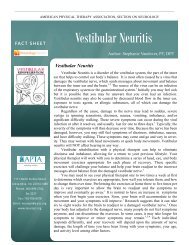Practice Guidelines for BPPV - Neurology Section
Practice Guidelines for BPPV - Neurology Section
Practice Guidelines for BPPV - Neurology Section
Create successful ePaper yourself
Turn your PDF publications into a flip-book with our unique Google optimized e-Paper software.
Vestibular SIG Newsletter <strong>BPPV</strong> Special Edition<br />
Differential Diagnosis and Treatment of Anterior Canal <strong>BPPV</strong><br />
By Janet Odry Helminski (continued from page 6)<br />
Positional Testing to Diagnosis <strong>BPPV</strong><br />
The Dix-Hallpike Test (DHT) is the standard clinical<br />
positional test <strong>for</strong> evaluating the vertical canals 7,10 . PC-<br />
<strong>BPPV</strong> is identified with the DHT with an estimated<br />
sensitivity of 79% (95% CI 65-94) and specificity of 75%<br />
(95% CI 33-100) 11 . Positional testing is best per<strong>for</strong>med<br />
with an examination tool that prevents visual fixation<br />
such as Frenzel goggles or video-oculography. Visual<br />
fixation suppresses ocular nystagmus. Vestibular<br />
suppressant medication that suppresses ocular<br />
nystagmus should also be avoided, such as Diazepam<br />
(valium) or Meclizine (antivert, bonine). If the patient has<br />
a history of vomiting, Ondansetron (Zofran) may be<br />
administered prior to treatment. Each position of the<br />
DHT should be maintained <strong>for</strong> a minimum of 45 seconds<br />
to allow debris to settle within the canal.<br />
The diagnostic criteria <strong>for</strong> AC-<strong>BPPV</strong> is vertigo associated<br />
with ocular nystagmus during the DHT. The vector of the<br />
ocular nystagmus is primarily downbeating with a small<br />
secondary torsional nystagmus directed towards the<br />
involved ear or no torsional nystagmus (50% of<br />
patients) 4 . The characteristics of the nystagmus include<br />
1-5 second latency be<strong>for</strong>e the onset of nystagmus,<br />
nystagmus < 60 seconds in duration, and fatigues with<br />
repeated positioning 4 .<br />
Figure 2. Algorithm <strong>for</strong><br />
differential diagnosis of AC-<br />
<strong>BPPV</strong>. Interpretation of<br />
findings from Dix-Hallpike Test.<br />
Dix-Hall Pike Test<br />
Head (R)<br />
Head (L)<br />
[+] nystagmus<br />
[-] nystagmus<br />
DH T<br />
ext<br />
geotrophic, torsional<br />
& upbeating Ny<br />
[reversal sit-up]<br />
downbeating Ny<br />
[reversal sit-up]<br />
horizontal<br />
Bi-DCPN<br />
[-] Ny<br />
[+] Ny<br />
pure downbeating<br />
head (R) & (L)<br />
downbeating with<br />
slight torsion<br />
18<br />
With AC-<strong>BPPV</strong>, findings on the DHT are difficult to<br />
interpret (Figure 2). In both the head right and head left<br />
positions of the DHT, the open end of the ampullary<br />
segment points downwards at about 40° from vertical 4 .<br />
Thus a positive downbeating nystagmus may be evoked<br />
in both the head right and head left position (Figure 3). If<br />
present, the direction of the small torsional vector of the<br />
nystagmus will be towards the involved ear 4 . For<br />
example, if the left AC is involved, in the head left<br />
position, the secondary torsional vector will be towards<br />
the left lowermost ear (geotropic) while in the head right<br />
position, the secondary torsional vector will be towards<br />
the left uppermost ear (apogeotropic). However, in 50%<br />
of cases, only downbeating nystagmus is observed in the<br />
dependent test positions making it impossible to identify<br />
the ear involved 4 .<br />
The DHT may produce a false negative in the head right<br />
and left position because the debris within the canal<br />
can’t clear the long arm due to the orientation of the<br />
ampullary segment. If the patient’s history suggests<br />
<strong>BPPV</strong> and the DHT is negative, the patient should be<br />
brought back into the recumbent position with the<br />
cervical spine in 30° of extension without cervical<br />
rotation 4 . Lack of rotation adds an additional 20° of<br />
downbeating Ny<br />
[reversal sit-up]<br />
PC lower most<br />
ear involved<br />
AC involved<br />
ear unknown<br />
AC torsion<br />
towards ear<br />
involved<br />
SRT<br />
AC <strong>BPPV</strong><br />
extension to the resultant<br />
position of the head. This<br />
enables the otoconia to clear the<br />
curvature of the long arm (Figure<br />
4). Authors have suggested a<br />
minimum of 60° of cervical<br />
extension is needed to clear the<br />
curvature 12 . The ability to<br />
position the patients into 60° of<br />
extension may be limited by both<br />
cervical and thoracic spinal<br />
dysfunction.<br />
Caution should be used with<br />
interpretation of findings on<br />
positional testing. In patients

















